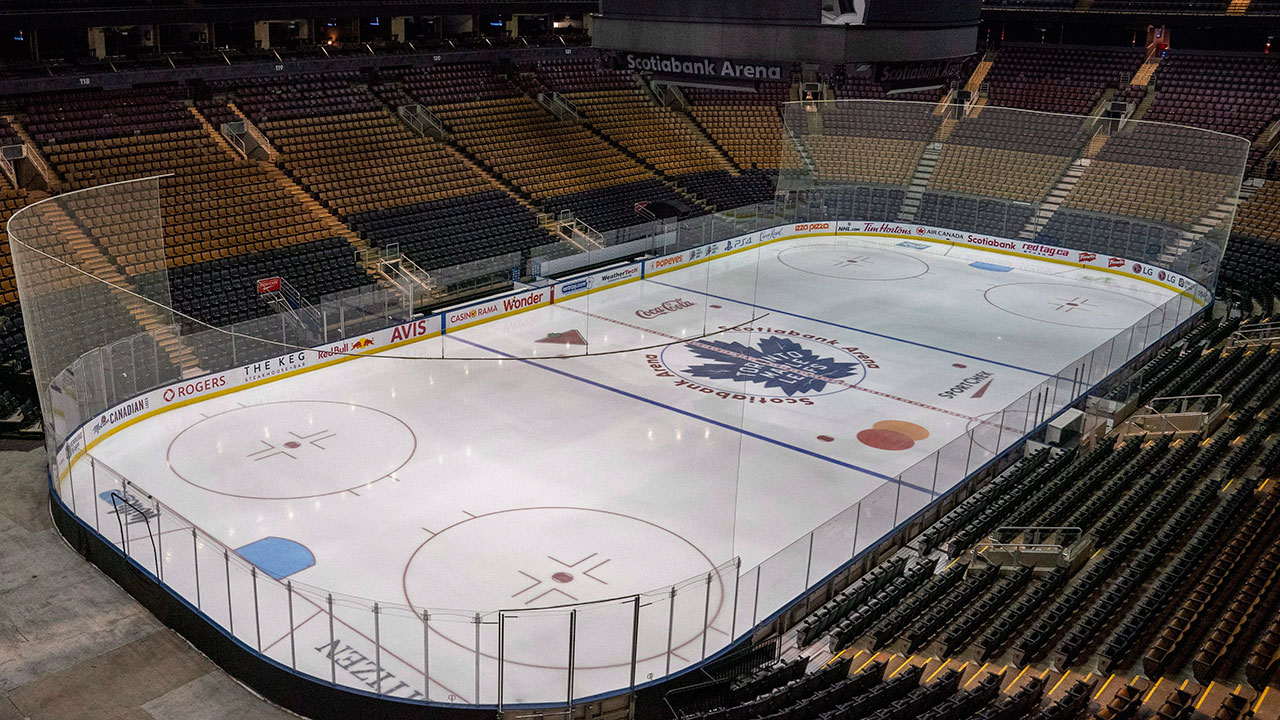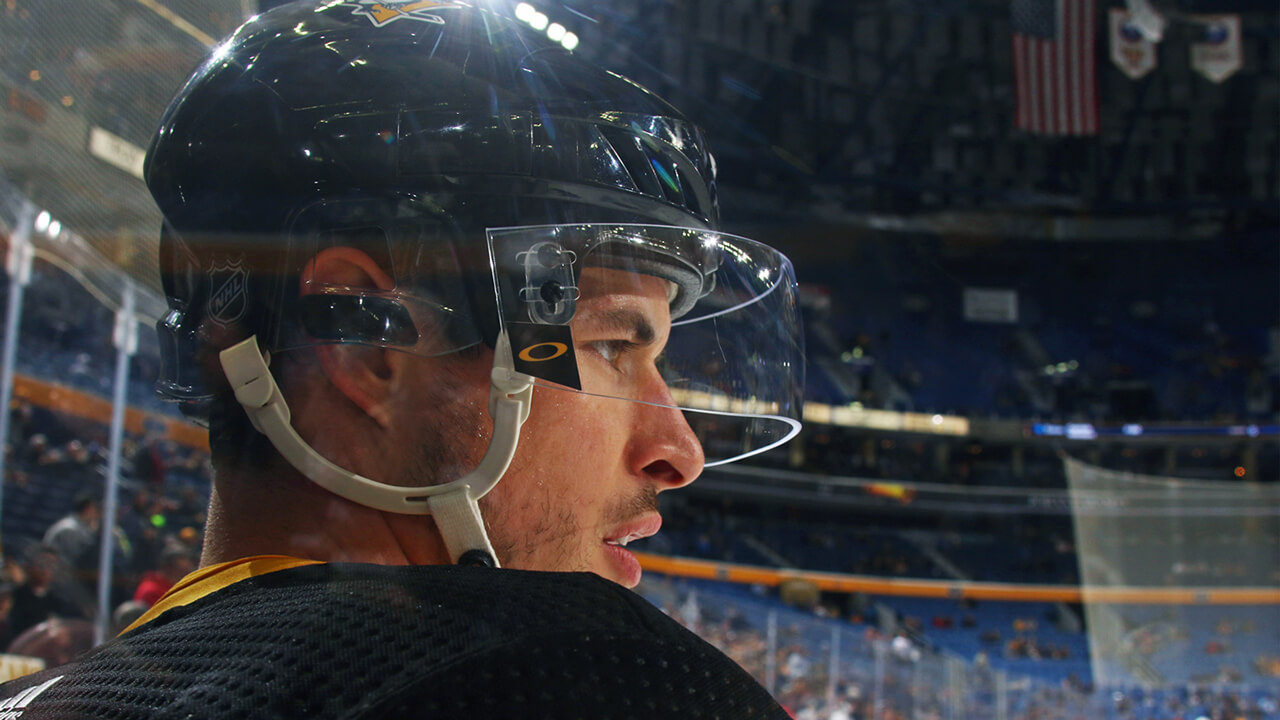Pat Dapuzzo is sitting in a booth at Biggie’s Restaurant, sipping on bubbly water and waiting on a lunchtime order of chicken fingers. At the same time, he’s in the next room over. Well, sort of. Framed on a brick wall by the bar here is evidence of Dapuzzo’s former career: A zebra-striped jersey encased behind glass along with a collection of photos, including a couple of him in action. A visitor walking over to check out the memorabilia makes Dapuzzo a little embarrassed. “Do you really need to see it?” he asks. Yes, please. Thank you.
Dapuzzo’s days as an NHL linesman are now more than a decade behind him. His career came to an abrupt and horrific end on a Saturday night in Philadelphia in 2008, when he suffered one of the most gruesome injuries in NHL history. But you wouldn’t know it by looking at him today: His brown hair hides a road map of scars, and feats of remarkable plastic surgery have reassembled parts of his face. In the booth, Dapuzzo brings a butter knife up to his forehead to point out the inch-long crevasse that appears between his eyebrows when he furrows his brow. The scar is the same width as a skate blade. It’s the only visible indicator of the moment that changed his life.
Dapuzzo hasn’t skated since he was guided off the ice 12 years ago. He says he’ll never skate again. But his is not a story defined by suffering or resentment, even if hockey did make him wonder whether he’d ever be happy again. This affable father of three has reinvented and rediscovered himself, and he’s enjoying yet another act in the game he fell in love with as a teenager.
To count the number of hockey careers the 61-year-old has influenced along the way is impossible. Boston Bruins defenceman Charlie McAvoy’s is one, and he says Dapuzzo “gave me a chance to follow my dream.” NHL deputy commissioner Bill Daly has been a friend of Dapuzzo’s for more than 20 years. “To see what he’s overcome, what he’s accomplished and what he’s doing today, I couldn’t be more proud,” Daly says. Dapuzzo is no longer sharing the ice with the greats and he may be as far from hockey’s spotlight as ever, but the man friends call “Dap” is in the midst of his most important and selfless work in the game yet. “He’s put his whole life into it,” McAvoy says.
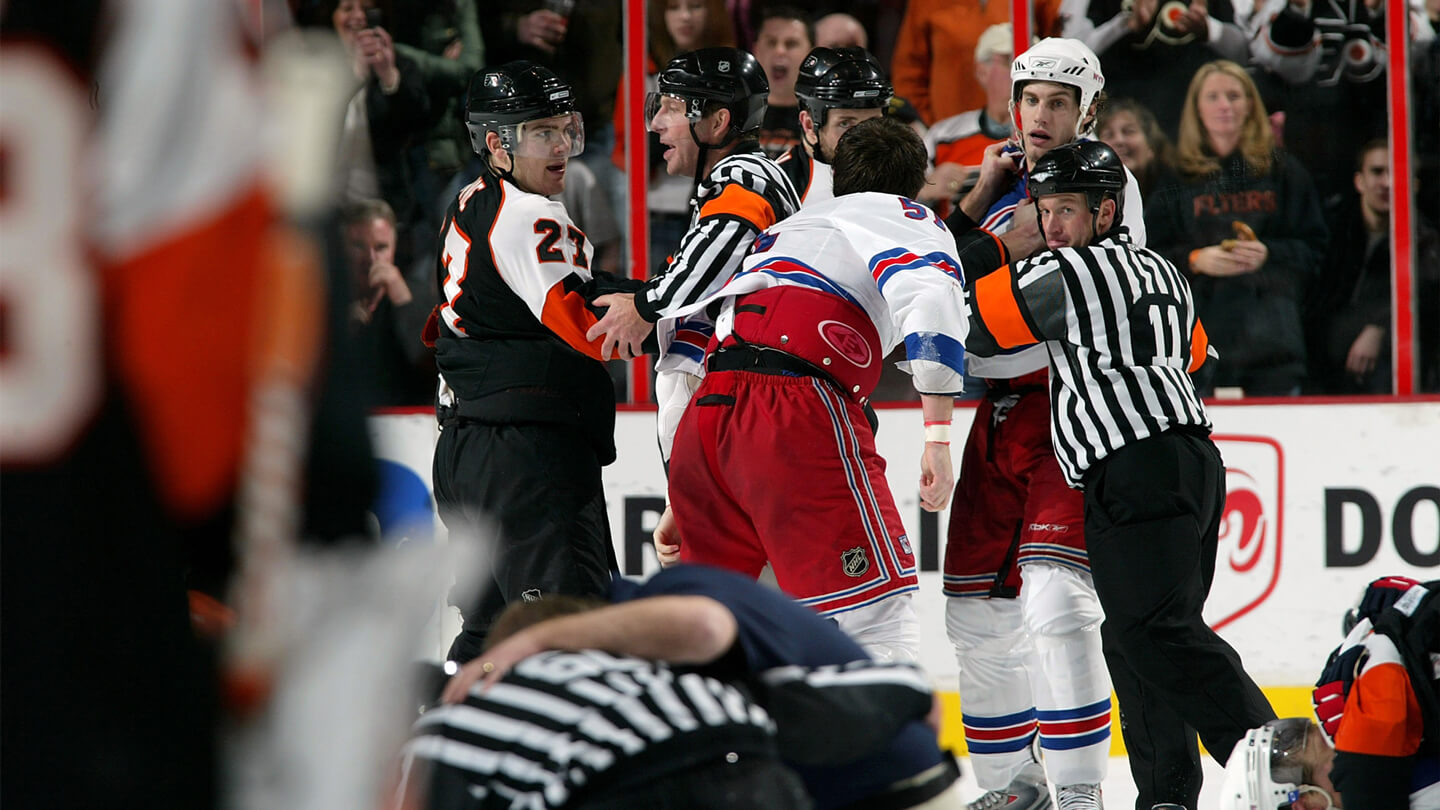
It’s a miracle to many in Hoboken, NJ, that Dapuzzo ever learned to skate or play hockey. Like everyone else there in the ’50s and ’60s, he didn’t grow up with the game. “You had to work really hard to get access to hockey,” says Daly, who’s also from northern New Jersey. Dapuzzo swears he didn’t know what the sport was until he was 14. “I was walking down the hill to my house and I saw these kids down this dead-end street and thought, ‘What the hell are they doing?’” he says. “I knew one of the kids, so I went over and said: ‘What the heck is this?’ He goes: ‘We’re playing street hockey.’ I had no idea.”
Dapuzzo was drawn to the pace of the game, and in Grade 10 he started playing in a league on ice in Jersey City. “I taught myself,” he says, of playing and skating. “Who’s going to teach me? We didn’t have Connor McDavid here or anything.” Not even close: The New Jersey Devils didn’t exist for another two years. Still, Dapuzzo took to the game quickly. He played in the Metropolitan Junior Hockey League as a high-school senior. He also picked up refereeing amateur games at 17, a career that started after he criticized an official in his own game, who told him: “You try it if you think it’s so easy!”
Dapuzzo took to officiating like it was. After working fewer than 50 amateur games, while still 17 years old, he was recruited to the old North American Hockey League, a lower-tier pro stop. “That’s the league where they made the movie, Slap Shot. I was in that league two years before they made that movie,” he says. “I knew Ogie Ogilthorpe — he was a real player [named Bill “Goldie” Goldthorpe]. Oh yeah, and the Hanson brothers were Steve and Jack Carlson — they all played.”
At 18, Dapuzzo started working both Div. 1 and AHL games as a linesman. The money was better in the NCAA, but he favoured the American League because of the pipeline it provided. “I wanted to try to make it,” he says, “and I wasn’t going to make it through college hockey.”
When two NHL linesmen were injured in December of 1984, Dapuzzo got his shot. Just six years removed from high school, the 25-year-old was the youngest person on the NHL’s officiating roster. “I’m on the ice with the Stanley Cup champion Islanders, and I’m getting $300,” Dapuzzo says, grinning, of his first NHL game. “It was my dream. I made it.”
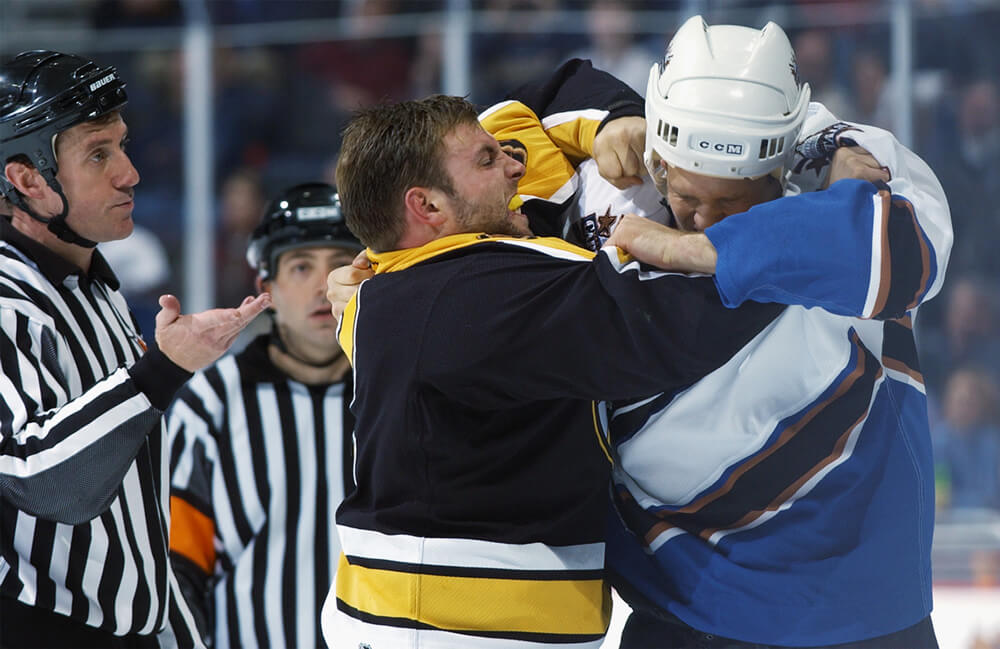
A dry-erase coach’s board is tucked into the passenger-side window shade, and the NHL Network is playing on the satellite radio. Dapuzzo settles into the driver’s seat of his Ford Explorer, which he calls “the hockey truck.”
As senior director of hockey operations for the ECAC (it’s one of six Div. 1 conferences, and covers the eastern U.S.), Dapuzzo drives as many as eight hours in this truck some days to take in a single game. Among his tasks is to keep an eye on the action, report back to the head office with any concerns and offer up guidance to officials.
“These kids play twice a week, between 35 and 40 games a year, and they go like nuclear missiles — 100 miles an hour,” Dapuzzo says. That speed is part of the reason he’s there to help the officials. “I think it’s harder to do the lines in college hockey than it is in the American League, because the kids don’t have the talent and [hockey] IQ.” A lot of teams play the trap, making for plenty of action along the boards. “If you divide the ice down the middle, usually nine of 10 players are on one side of the ice,” he explains. “If you’re the weak-side linesman, you’ve got nobody on your side of the ice, so you’ve got to join the rush. If your partner has to go into the zone so he doesn’t get killed, you’re there. If he has to pull up short, you’re there. You communicate and it’s like a yo-yo.”
Dapuzzo has been a part of ECAC Hockey’s head office nearly 12 years now, having started not long after his NHL career ended. It boggles the mind of commissioner Steve Hagwell that he has someone with Dapuzzo’s depth of experience on staff. This is a guy who officiated Wayne Gretzky’s last NHL game, for Pete’s sake. Hagwell figures Dapuzzo could be working at any level of hockey, yet he chooses the ECAC. The two are in regular contact — Dapuzzo, via a flip phone (be prepared to wait a while if you text him). “He’ll call and say, ‘I’m on my way to Harvard,’ or ‘I’m on my way to Union,’” Hagwell says. “He knows the players — he’s not just about the officials. He’s done some coaching, and he’s well aware of everything on the ice. We’re always chatting about officiating and things he’s heard and wants to appraise me of. He’s almost my feet on the ground out there to a degree. And he’s got so much knowledge that he’s handing down to the officials. To have his help, I can’t even describe how valuable that is, how lucky we are.”
One of Dapuzzo’s strengths is that he’s a great teammate, Kelly Sutherland explains. The referee broke into the NHL in 2000 and worked alongside Dapuzzo a lot. “You knew this guy had your back,” Sutherland says. “There were things you didn’t even know Pat did on the ice at the time. You’d find out afterward. He’d go, ‘Oh, this guy said this, so I put him in his place by doing this.’ That’s how Pat worked. I was like, ‘Oh, thanks!’ I was thinking everything was going smoothly out there, meanwhile it maybe just seemed that way because of him.
“It’s not exactly by-the-book teaching,” Sutherland adds, laughing. “But everyone responded to him. They liked him.”
Brian Burke was the NHL’s executive vice president and director of hockey operations when he first got to know Dapuzzo in the early 1990s. He says the referee’s relationship with players stood out. Dapuzzo was the guy they’d ask where to find the best Italian food in New Jersey, or where to get a decent haircut. “He’s a good skater, he’s a good athlete, so the players respected that, but also I think he really worked at the relationships, remembering people’s names and talking to them at faceoffs,” Burke says. “I think he worked to develop that rapport. It didn’t exist with a lot of officials.”
Those connections are part of what makes Dapuzzo a valuable resource in the ECAC today. “There’s no doubt in my mind I wouldn’t do some of the things I’ve done in hockey if it wasn’t for Pat,” says linesman Ryan Knapp. “He’s almost like a Godfather-type figure in hockey: he knows everybody and everybody has great respect for him. As I was moving along with college hockey, he helped me out tremendously. He was always at games, always there for words of encouragement. If there was ever a sticky situation, you could talk to him about it.”
To Hagwell, that’s Dapuzzo’s most valuable asset. “He enjoyed his NHL career,” he says, “and now he’s at a stage in his life and his career where he’s passing the torch, the information, the knowledge.”
Hagwell’s only frustration with Dapuzzo is that he won’t accept any recognition for his work. He won’t take a stipend to cover food and gas on road trips. He isn’t paid a salary. Dapuzzo is a volunteer who treats his role like many would a full-time job.
“That tells you everything about his dedication,” Hagwell says. “This is a love affair for Patrick.”
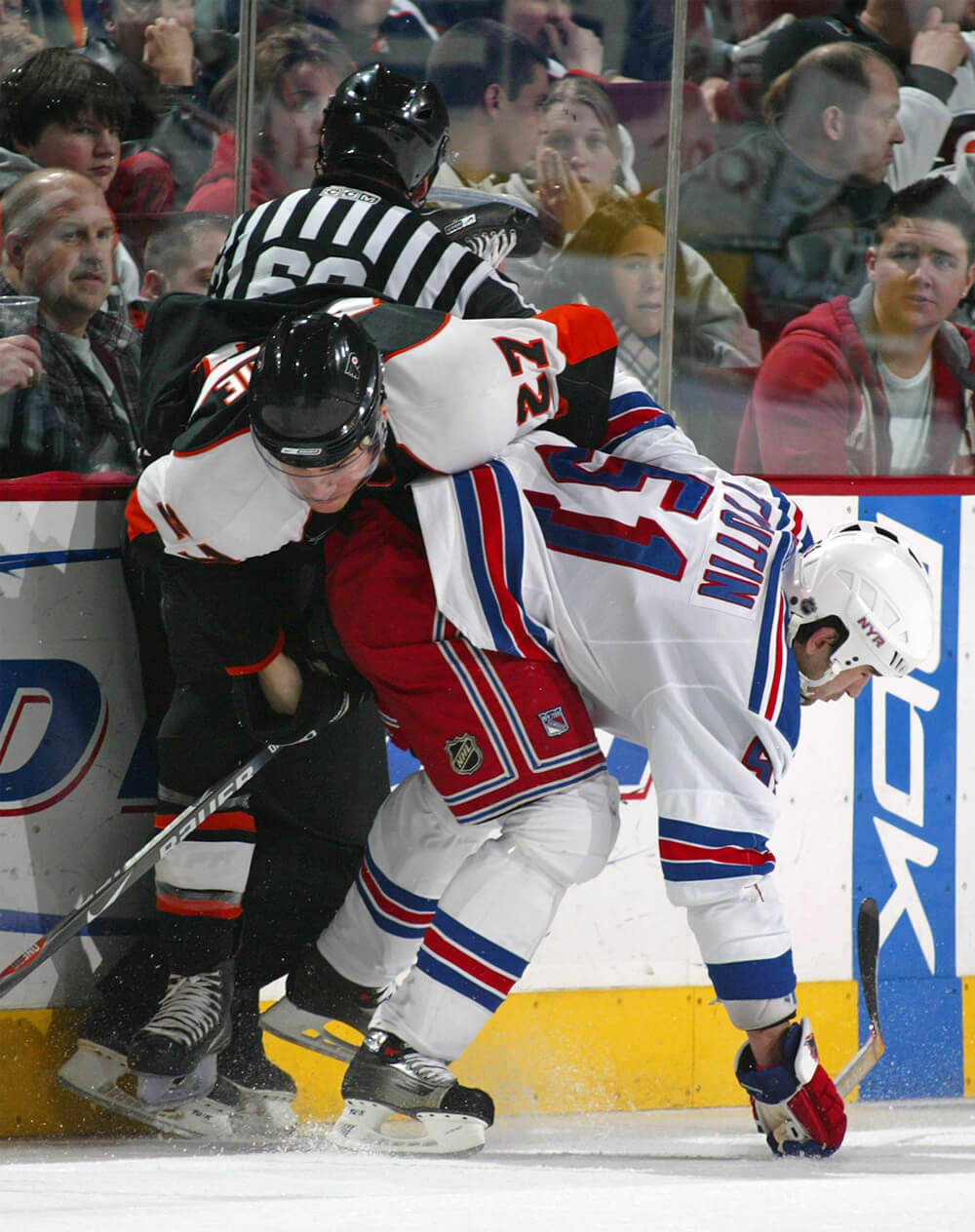
The puck is hurtling up the boards toward Dapuzzo. Fedor Tyutin and Steve Downie are hurtling across the ice towards that puck. Dapuzzo gets out of the way as best he can, jumping to try to avoid the ensuing collision, his skates airborne, his knees tucked. Tyutin lays a hip check on Downie, flipping the Philadelphia Flyers winger nearly upside down, sending one of Downie’s skates hurtling through the air.
Before Dapuzzo knows it, he’s on his knees. Blood is pooling beneath him on the ice and he’s holding his nose onto his face. “There was just a hole there,” he says.
“He starts to leave the ice, bleeding, and actually tries to come back on, because a line brawl had broken out,” says Sutherland, who was working that night. “We had to force him off. He wanted to continue to do his job. And because he was so tough, that night we thought, ‘Oh, he just got a cut.’ We thought, ‘Pat’s going to need some stitches.’ He never really showed that he was ever hurt. And considering how badly he was hurt, most guys would’ve stayed down, too, right?”
Dapuzzo’s nose was reattached with black thread — he needed more than 40 stitches. “The doctor told me, ‘If you go back out there, you could get hit and you could die,’” he says. They didn’t yet know the full severity of his injuries.
At a trauma centre in Camden, NJ, Dapuzzo found out he had 10 facial fractures, including a shattered right cheek bone, which caused his right eye to droop. His jaw was broken. The ligaments in his neck were damaged. Later, he’d wear a cast on his face for four months and have three surgeries, including a rhinoplasty to fix his nose and improve his breathing. “The pain would bring me to my knees,” he says. His back teeth were removed to try to relieve some of the pressure he felt in his head and ears — eventually, all the rest of his teeth fell out because the nerves were dead. He lost his sense of taste. The headaches were nonstop.
Dapuzzo had worked 1,532 regular-season games and 62 in the playoffs over a 24-year NHL career. “All those years, and then just like that,” he says, snapping his fingers. “It was gone.”
It was a career-ending blow that night in Philadelphia, but Dapuzzo’s struggles began long before his days as a linesman ended. For more than a decade prior to his accident, he’d been getting headaches. Lights bothered him. He had anxiety. He battled depression. He once collided with a player and then threw up in the penalty box before returning to the action still dizzy. Several times he was hit into team’s benches. Once, he took a deflected slap shot off the cheek. He got stitched up and returned to work 12 minutes later.
In all that time, the worst he felt was a day away from the biggest assignment of his career: Game 6 of the 1995 Eastern Conference Final between the Flyers and Devils. He’d been getting closer to officiating in the pinnacle of professional hockey. “I’m one step from the Cup,” he says. But the night before that assignment, he lay in his dark hotel room, throwing a pillow at the ceiling over and over again, trying to distract himself from the pounding in his head and his racing heart. It didn’t work.
On game day, Dapuzzo drove to a hotel in New Jersey along with referee Don Koharski. When they arrived, he dropped Koharski off. “Find somebody else to do the game tomorrow,” Dapuzzo told him. “I’m not working.”
He drove himself straight to the hospital feeling like he might be having a fatal heart attack. After he was admitted, doctors sent him for an EKG, told him he was okay, and sent him home. “It was all part of the anxiety,” he says.
Burke called Dapuzzo into his office a few days after the linesman failed to report for the game. “For an official to give up an assignment in the conference finals is unheard of,” Burke says. “He told me he just didn’t feel right, and I said, ‘Well, that’s not good enough, Pat. What do you mean you just don’t feel right? Were you sick?’”
Dapuzzo told Burke he couldn’t focus, had trouble getting out of bed, his anxiety was through the roof, that he didn’t know what was wrong, that he’d never felt quite this bad. Burke sought out commissioner Gary Bettman to figure out how to get Dapuzzo help. After some digging they were referred to the psychiatrist the New York Mets employed. (Burke vetted the doctor first: “I’m not going to send Pat there if he’s a quack,” he explains.) “I think that shrink might’ve saved Pat Dapuzzo’s life,” Burke says. Finally, Dapuzzo began to get some of the treatment and help he needed.
Dapuzzo worked the 1995–96 season, but he missed 1996–97 while continuing to get treatment, which the NHL covered. “I went to get help, where I started to feel a little better and have some relief,” Dapuzzo says. “I ruined my whole career — my whole career. I was going to do the Stanley Cup Final in ’95 and I walked out on Game 6 of the conference final because I thought my head was going to explode. And nobody – nobody – knew. You got your bell rung. Nobody talked about, ‘I don’t feel good because I think I have brain trauma.’”
Dapuzzo returned to the NHL for the 1997–98 season, but over the course of the next decade, he was never assigned to another playoff game. “I didn’t feel like myself,” he says.
It wasn’t until he was forced off the ice that he truly would again.

A Pat Dapuzzo influence story, courtesy of Charlie McAvoy: The Bruins defenceman was 13 when they met in 2011. He was playing for the New Jersey Rockets along with Patrick Jr., the second of Dapuzzo’s three sons, who McAvoy calls “Patches.” McAvoy and Patches hit it off, and their families became close. Having the NHL aspirations he did, McAvoy picked Dapuzzo’s brain any chance he got. “Every time he would come to games, I’d look for him after, and just knowing his background — he always loved to just talk hockey and catch up,” McAvoy says.
The team was run like a junior squad and would travel by bus to most games. Dapuzzo was one of the few parents who’d be in attendance, almost like the team’s chaperone. McAvoy says: “He really picked up a father-type presence.”
After one game late in the season, Dapuzzo asked McAvoy when he was leaving for Ann Arbor, Mich., for U.S. national team development camp tryouts, which were four days away. McAvoy hadn’t been invited. “He couldn’t believe it,” says McAvoy, who was disappointed, but had made his peace with the decision. Dapuzzo wasn’t ready to throw in the towel, and he told McAvoy so: “There’s no way this isn’t happening. You deserve to be there.” Dapuzzo got on his phone and one call led to another. A couple days later, McAvoy was invited to the camp. After his first game there, 24 Div. 1 colleges contacted Dapuzzo to offer McAvoy a free ride. “They came to me because nobody knew who he was or where he came from,” Dapuzzo says.
“Without Pat, I definitely wouldn’t have been the guy who got a chance to go and try out for that team,” McAvoy says. “It was nothing other than Pat being Pat. He’s so selfless and anybody he cares about, he’ll do anything, go above and beyond, to show that love that he has for you and to protect you.”
McAvoy calls his time with the USNTDP “two of the biggest years of my life,” which led to his growth as a player and ultimately getting to where he wanted to in the game.
“He always says, ‘I just made a phone call, that’s all I did,’” McAvoy says with a laugh. “It’s the modesty in Pat. It was a lot more than that to me.”
Dapuzzo has worked at the NHL level again since he was forced out 12 years ago. For five years, he served as a part-time scout for the Toronto Maple Leafs. It was Burke, then the team’s GM, who offered up the job.
Three years had passed since Dapuzzo’s accident, and he’d been struggling. The year after he was injured, he rarely left his house. He didn’t feel well enough to interact much with his sons. He wouldn’t respond to most friends who called, texted or knocked on his door. And though Dapuzzo had been slowly improving, in the back of Burke’s mind, concern was one reason he wanted to see if Dapuzzo was interested in the scouting role. “But you can’t make hiring decisions based on that,” Burke says. “It was, ‘Yeah, he’s my friend and it’ll be good for him.’ But mostly it was, ‘This guy’s going to help us.’
“I thought — and I was right — that youth hockey in the New York-New Jersey area was exploding. And we didn’t really have a guy; we didn’t have boots on the ground there. Not only did I trust Pat as a judge of talent, but he knows these kids too, he gets to know their families, he can tell you everything about a kid. I thought it was the right guy for us to have on the ground there.”
Dapuzzo took Burke up on the offer, because he wanted to stay busy and also because he considered the job a cake walk. He had coached and had also seen players come up through the ranks while playing alongside his sons — McAvoy, the van Riemsdyk brothers, John Carlson, Zach Aston-Reese, Adam Fox, Connor Clifton and Jeremy Bracco, to name a few. “This area where I live — the metropolitan area, down toward Philly, up in Connecticut — we’ve got over 30 million people,” he says. “Are you kidding me? Seven rounds, I had to find one guy each year that could play in the NHL. I had eight of ‘em!”
During Dapuzzo’s time as a scout, Burke says, “the guys he recommended always turned into players.” And slowly, Burke started to see his friend’s physical and mental state continue to improve. “When he was down, when he was battling stuff, he just never smiled, he was kind of low key, kind of despondent,” Burke says. “And then you could see when things were going well for Pat, he’s got a big smile the whole time, he’s got a bounce in his step, he’s got lots of energy. You could see that he was back.”
After five years with Toronto and back in the NHL, Dapuzzo opted to focus solely on his role with the ECAC, in large part in order to spend more time with his family. Today, he says he’s truly happy again, that he has felt entirely like himself for the past two years. He still gets headaches sometimes, and he won’t risk working out for fear of what getting his heart rate up could do to his head. “I don’t want to do anything where it could compromise me, you know?” he says. “I didn’t feel good for so long. It had to be close to 20 years.”
Dapuzzo held off donning a helmet longer than most, and a visor could have saved his career. “I wouldn’t want anybody to go through what I went through, but there’s a reason things happen,” he says, after polishing off his chicken fingers. “Maybe I needed to do that so the league would make guys wear visors. Maybe I had to take the hit.” Dapuzzo has agreed to donate his brain and spinal cord to science.
What Daly knows is that his friend continues to have an indelible impact. “He couldn’t be a better ambassador for the game,” Daly says. “I think Pat has done a remarkable job of reinventing himself off the ice, taking advantage of his strengths, taking advantage of his hockey knowledge. And certainly that was evident when he worked with Toronto, but he’s been very instrumental in youth hockey in the New Jersey and mid-Atlantic states area, and continues to have a very positive impact on youth development in our area. It’s a real credit to Pat to volunteer his time in furtherance to the sport. We’re very fortunate to have him.”
Sutherland caught up with Dapuzzo in Boston last year during the Stanley Cup Final. “That was the best I’ve seen him since he was on the ice,” Sutherland says.
There’s still a ‘Patrick Dapuzzo’ on college game sheets today: Patches, his son, is a referee. Dapuzzo’s eldest, Anthony, is a linesman, yet another mark of his influence on hockey.
That’s just the latest benefit of continuing to work in this game, if you ask Dapuzzo. “I missed a lot while I was working in the NHL, and now I’m around for everything,” he says. “I’m watching great games, and sometimes my sons are working. We get to spend more time together than ever. Everything happens for a reason.
“And, you know,” he adds, “It’s all because of hockey.”


